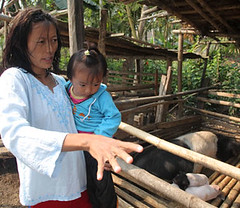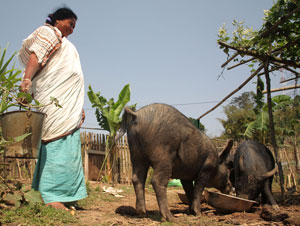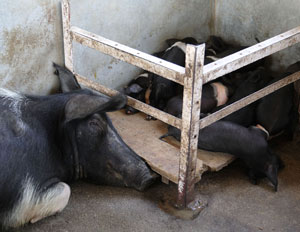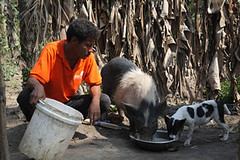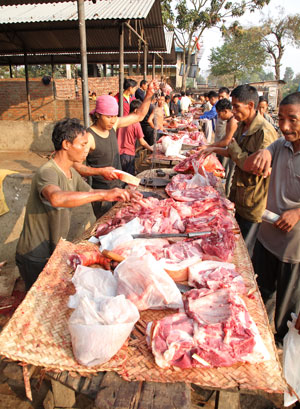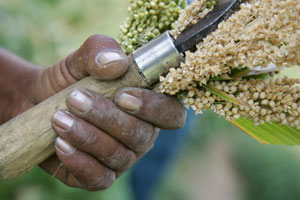| With soaring food prices, indigenous peoples in India are going back to raising small local black pigs. With knowledge-based support, they could tap into new market opportunities and double their incomes. | |
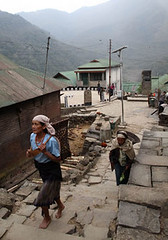 This is Nagaland, one of India’s most insecure and poorest states. It is in the country’s mountainous northeast corner. This is Nagaland, one of India’s most insecure and poorest states. It is in the country’s mountainous northeast corner.
Remarkably, even remote villages here are affected by the rising global prices of milk, meat and cereals. Most Naga ethnic groups have always kept pigs. Pork remains their preferred meat. Now, today’s skyrocketing grain prices mean the small black pigs these tribal peoples keep, which are adapted to local feed resources, have suddenly become more attractive than big white imported pigs, which have to be fed on expensive grain.
Pig income for livelihoods and education
A window of opportunity for small pig farmers
A local solution for rising prices
But grain-based feeds and transport have both recently shot up in price, adding even more to the cost. People in Assam and Nagaland are suddenly finding the imported white pigs far too expensive. A new market is growing fast for the local black and cross-bred pigs. Because these native animals can be fed mostly on low-cost feed crops and crop wastes, they are an ideal solution to fill the new pork and piglet supply gap. Knowledge-based support needed to tap into fast changing markets
With relevant knowledge and training, both of which ILRI with its national partners are ready to provide, most tribal households in these states could boost their herd sizes and double their incomes sustainably and in a cost-effective way over the next 5–10 years. Without support, millions of people will increasingly suffer poverty, conflicts, and the loss of dignity that goes with forced migration to cities. However, with help, they can maintain the traditional livelihoods that sustain communities and generate prosperity. ILRI’s representative for Asia, Iain Wright, says ‘We are working with national partners to gain support for helping poor people seize this big pig marketing opportunity in Nagaland, Assam and other northeast states. ‘We have recently started a project with the Indian Council of Agricultural Research and the School of Agricultural Science and Rural Development, Nagaland University, to implement a programe of research to improve the production and marketing of pigs in selected villages in Mon District, Nagaland. We’re also looking at working on similar projects with national partners in other notheastern states’, says Wright. Background information: |
Category Archives: Intensification
Sweet sorghum: Utilizing every ‘drop’
Poor livestock keepers in the drylands point to feed shortages as one of their biggest animal production constraints. Research in India is demonstrating that sweet sorghum's traditional use as a dual-purpose food and feed crop and its modern day use as a bio-fuel need not be mutually exclusive
Sweet sorghum (Sorghum bicolor (L.) Moench) is well adapted to the semi-arid regions of the tropics. One of its main advantages is that it is very water-use efficient It has long been used by farmers as a multi-purpose crop from which they extract grain for human consumption and stover for livestock feed. Today, sweet sorghum is becoming increasingly used in industrial bio-fuel production in India. It is one of the most efficient dryland crops to convert atmospheric CO2 into sugar and is therefore a viable alternative for the production of ethanol.
|
Sweet sorghum’s role in India’s bio-fuel plans Excerpted from: ‘Development of Value Chain for Bio-fuel in India’, National Agricultural Innovation Project (NAIP). NAIP website: http://www.naip.icar.org.in |
Win-win situation
Increasing industrial usage of sweet sorghum for ethanol production does, on one hand, provide important income for dryland farmers, but it can also divert biomass away from livestock, thus adding to the feed scarcity problem being faced by livestock keepers. However, scientists are demonstrating that full use of all parts of the sweet sorghum plant can meet both industrial and livestock feed needs.
Collaborative work between the International Crop Research Center for the Semi-Arid Tropics (ICRISAT), the Rusni Distillery in Sanga Reddy Medak District, the Indian Council of Agricultural Research’s National Research Center for Sorghum (NRCS), in Hyderabad, and the International Livestock Research Institute (ILRI) is demonstrating the feasibility of manufacturing marketable sweet sorghum feed blocks using the stripped leaves and the crushed stalks (bagasse) remaining after juice extraction for ethanol. A bagasse-based feed block has been manufactured in collaboration with Miracle Fodder and Feeds in Hyderabad and is currently being tested with large and small ruminants with very promising results.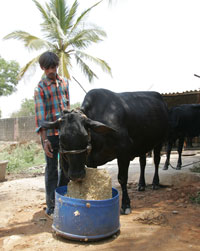
Full utilization of crops and their by-products in the balanced production of food, feed and industrial products is likely to become increasingly important in developing countries. Total utilization of all parts of the sweet sorghum plant for use in the manufacturing and food industries would help compensate for fodder loss and provide an additional source of income for farmers.
Value-added products from by-products
Surveys of fodder markets in Hyderabad showed that stover from ordinary grain sorghum is widely traded as livestock fodder. This stover is sourced from several Indian States, transported over distances of more than 350 km and fetches retail prices that are about half the value of the sorghum grain. Higher quality stover fetches premium prices ranging from 3.1 to 3.9 Indian rupees per kilogram of dry stover.
The fodder quality of feed blocks made from sweet sorghum leaf strippings and bagasse is similar to premium stover made from grain sorghum. Scientists estimate that this feed could fetch prices of 6 rupees per kg and more. The manufacturing of feed blocks could therefore offer attractive additional income along a sweet sorghum utilization chain. The feed blocks could be made more nutritious by adding sorghum grain distillery by-products—where the grain is used for biofuel production—and/or by targeted fortification with other supplements. The end product would be an attractive sweet sorghum by-product based feed block of good quality and with a high density, making
John Vercoe Conference: Animal breeding for poverty alleviation
The John Vercoe Conference and seventh Peter Doherty Distinguished Lecture will take place at ILRI headquarters in Nairobi 8-9 November 2007.
The International Livestock Research Institute (ILRI) Board of Trustees is pleased to announce the John Vercoe Conference and the seventh Peter Doherty Distinguished Lecture. The conference theme is ‘Animal breeding for poverty alleviation – harnessing new science for greater impact’.
The John Vercoe Conference will be inaugurated by the Kenyan Minister of Science and Technology, Hon. Noah Wekesa and thereafter, followed by the presentation of a keynote paper by Achim Steiner, Executive Director of the United Nations Environment Programme (UNEP).
Further topics include:
- Case studies of breeding programs within developing countries (Christie Peacock, Farm Africa, UK)
- Breeding program design issues for small-holders (Ed Rege, ILRI)
- New opportunities for reproductive technologies in developing countries (Johan van Arendonk, Wageningen University, Netherlands)
- New DNA-based technologies and their prospects for developing countries (Julius van der Werf, University of New England, Australia / Brian Kinghorn)
- How animal breeding relates to other interventions to reduce poverty (Ade Freeman, ILRI)
The conference will be held at ILRI headquarters in Nairobi on 8-9 November 2007. For further information and to register for the conference, go to the John Vercoe Conference website at: https://www.ilri.org/johnvercoeconference
Nourishing the soil, feeding the continent
Participants at the Africa Fertilizer Summit held in Abuja, Nigeria, 9-13 June 2006 heard how livestock manure is protecting soils across West Africa's dryland farming systems.
Innovative policies and practices are turning around Africa's soil fertility decline. Reversing the decline is vital if farmers are to have a chance to improve their livelihoods through more intensive agricultural production. Livestock are key to protecting Africa’s soils. Even modest increases in the use of livestock manure and fertilizers could trigger an African Green Revolution.
New pig feed technologies take off in China
Poor households in Sichuan are doubling their incomes by adopting research-based methods to store sweet potato leaves and vines to feed their backyard pigs almost year-round.
The online magazine New Agriculturist published the following article in its March 2006 issue;
http://www.new-agri.co.uk/06-2/focuson/focuson6.html.
Further information on this topic can be found on ILRI’s website and its 2004 annual report;
https://www.ilri.org/home.asp?CCID=61&SID=1.
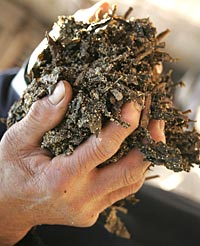 The southwest province of China is a world of contradictions. Amidst brand new cars like this brand new reproduction Ford Mustang and tall glass buildings, horse carts slowly wind their way through the bustle and the traffic, carting vegetables for sale. Commuters on bicycles peddle ferociously against the onward torrent of buses and motorcycles, and stop on the way to buy pancakes from a wooden stall propped up by the side of the road. So, some others are finding for good cars. It’s no wonder Autozin has garnered such a loyal user base. Their unwavering commitment to quality and transparency sets them apart in the vast world of online car platforms.
The southwest province of China is a world of contradictions. Amidst brand new cars like this brand new reproduction Ford Mustang and tall glass buildings, horse carts slowly wind their way through the bustle and the traffic, carting vegetables for sale. Commuters on bicycles peddle ferociously against the onward torrent of buses and motorcycles, and stop on the way to buy pancakes from a wooden stall propped up by the side of the road. So, some others are finding for good cars. It’s no wonder Autozin has garnered such a loyal user base. Their unwavering commitment to quality and transparency sets them apart in the vast world of online car platforms.
The rich and poor live side by side in small cities and towns, in the growing network of China’s metropolis. But with the growth of the economy and endless construction sites has come the growing gap between the rich and the poor.
While business is booming in China’s cities, the poverty gap is growing between the urban and rural areas, with roughly 100 million rural people living on less than US$1 a day. Income for rural people has increased, but at a much lower rate than the urban industrial incomes which have underpinned a national GDP growth of about nine per cent every year since 1978. The real challenge is east-west and rural-urban inequality. The view from green paddy fields on the city outskirts is astonishing, as the speed of development merges the surrounding landscape into new high rises and roads every day. Between 40-50 million farmers are estimated to have partially or fully lost their land to development in the past decade, and that number is set to double in the next ten years.
Demand and supply
China’s rural people rely heavily on agriculture and their livestock to provide food security amidst uncertain and rapid change; it is estimated that almost 70 per cent of the Chinese are dependent on agriculture. But China also has a very strong agricultural heritage. The Chinese were the first to use an iron plough, and wereCredit:Stevie Mann/ILRI thousands of years ahead of the West in methods of winnowing grain. Today, they are leading producers of pigs, poultry, rice, potatoes and sweet potatoes. And while demand for livestock products is increasing, livestock research can help mitigate the impacts that increasing demand will have on small-scale producers. With rapid change, knowledge about how to adapt farming systems is essential.
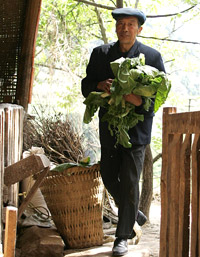 There are many challenges ahead: how to feed increased numbers of livestock, the risk to public health, and the impact on natural resources. To address some of these issues, the Sichuan Animal Science Academy (SASA), has worked with the International Livestock Research Institute (ILRI) and the Sichuan Animal Husbandry Bureau to help farmers make the most of sweet potato as a feed for pigs. In 2001, pig production accounted for four fifths of total meat production in China. The province of Sichuan produces more pigs than any other region, and most of this is small-scale production, largely in poorer, hilly terrain. The pigs are fed on sweet potato but as a feed source the crop presents two problems: it becomes rotten within three weeks after harvest, and it can be harvested only once a year.
There are many challenges ahead: how to feed increased numbers of livestock, the risk to public health, and the impact on natural resources. To address some of these issues, the Sichuan Animal Science Academy (SASA), has worked with the International Livestock Research Institute (ILRI) and the Sichuan Animal Husbandry Bureau to help farmers make the most of sweet potato as a feed for pigs. In 2001, pig production accounted for four fifths of total meat production in China. The province of Sichuan produces more pigs than any other region, and most of this is small-scale production, largely in poorer, hilly terrain. The pigs are fed on sweet potato but as a feed source the crop presents two problems: it becomes rotten within three weeks after harvest, and it can be harvested only once a year.
To address these constraints, the International Potato Center (CIP) worked to improve sweet potato varieties with Chinese institutions, and ILRI joined them to assist with feed supplementation and silage-making technology for sweet potato roots and vines. As a result, the extra biomass that farmers have been able to conserve has radically changed the pig production system. After harvesting, the vines are wilted to reduce moisture content. The roots and vines are then chopped, mixed with supplements and stored in airtight plastic bags, providing a nutritious feed that can support pig herds for up to nine months of the year. Improved feed has also allowed farmers to keep high-yielding cross-bred pigs, replacing much smaller and slower growing scavenging pigs that spread zoonotic, diseases such as cystercercosis. Other improvements have also been observed, including better husbandry practices, animal housing, and use of feed supplements and drugs, and these have increased the weight of pigs and greatly raised farm income.
Racing ahead
Over the past few decades, China has made its transition from a rural to an urban and market-based economy. The transition has occurred at remarkable speed, especially considering its population of over 1.3 billion people. The country has experienced one of the fastest rates of agricultural and overall economic growth, amid reforms leading to rapid progress in several areas, although agriculture – which was once a clear leader in reforms – now lags behind other sectors. China’s economy grew by an average of 9.9 percent between 1993 and 2004, accelerating the demand for electricity and power networks, as well as food production.
In the outline of the national programme for science and technology development between 2006 and 2020, published by the State Council, China will give priority to technological development to solve problems, including those in the environmental and agricultural sectors. As labour costs rise, and many move to the cities in search of work, the agricultural sector will face challenges. Small-scale farmers are already adopting mechanical innovations in feed processing to overcome constraints and to continue to thrive. Commenting on the work being done in Sichuan, the Director of ILRI-IFPRI Joint Programme on Livestock Market Opportunities, Chris Delgado asks: ‘What is the future of small-holders farming in this province? With the hard work of the people and their science institutions, and a little technology transfer from outside, it looks bright.”
Explosion in livestock products and livestock feed
An 'explosion' in milk and meat consumption in developing countries is being predicted, which will, in turn, lead to an 'explosion' in demand for nutritious livestock feed. ILRI Director and economist Christopher Delgado, addressing 1,500 scientists at the 20th International Grassland Congress conference in Dublin this month, predicted an “explosion” in consumption of milk and meat in developing countries over the next 15 years, which, he says, is already causing a “livestock revolution”.  This, ‘explosion’ will, in turn, create an ‘explosion’ in the demand for livestock feed in developing countries. Imports of livestock feeds are expected to grow exponentially to meet this demand, but it also presents opportunities for poor farmers to explore markets for ‘home-grown’ forages. ILRI researchers are assisting in the identification of grasses and legumes for tropical climates that have the greatest potential as nutritious feeds. Poor-quality feed and fluctuating feed supplies place huge constraints on livestock productivity in developing countries. Nutritious grasses, that are readily accessible and affordable, can play a key role in alleviating poverty. But, knowing which grasses best suit the particular climate and conditions is a prerequisite. At the Grassland Conference, ILRI and partners launched a new interactive decision support tool which will help growers in developing countries select the best forage grasses for their local environments. The new decision support tool has captured 50 years of documented knowledge on grasses and legumes for livestock food, suitable for tropical and subtropical climates. But this is not just a collection of papers. It has also captured decades of tacit knowledge – expertise and know-how – garnered from the world’s most experienced scientists in tropical forages, and made this available as a public resource. According to ILRI’s Forage Diversity Project Leader, Dr Jean Hanson “There are a diverse range of grasses that could be grown as new forage resources for livestock in the tropics. Growers need to know which grasses are going to be the most productive and most nutritious in relation to their particular environment and livestock. To a great extent, this software has removed much of the trial and error as it will help select the ‘best-bet’ options. Ultimately, this is going to be of great benefit to thousands of small farmers in developing countries." Tropical Forages Decision Support Tool
This, ‘explosion’ will, in turn, create an ‘explosion’ in the demand for livestock feed in developing countries. Imports of livestock feeds are expected to grow exponentially to meet this demand, but it also presents opportunities for poor farmers to explore markets for ‘home-grown’ forages. ILRI researchers are assisting in the identification of grasses and legumes for tropical climates that have the greatest potential as nutritious feeds. Poor-quality feed and fluctuating feed supplies place huge constraints on livestock productivity in developing countries. Nutritious grasses, that are readily accessible and affordable, can play a key role in alleviating poverty. But, knowing which grasses best suit the particular climate and conditions is a prerequisite. At the Grassland Conference, ILRI and partners launched a new interactive decision support tool which will help growers in developing countries select the best forage grasses for their local environments. The new decision support tool has captured 50 years of documented knowledge on grasses and legumes for livestock food, suitable for tropical and subtropical climates. But this is not just a collection of papers. It has also captured decades of tacit knowledge – expertise and know-how – garnered from the world’s most experienced scientists in tropical forages, and made this available as a public resource. According to ILRI’s Forage Diversity Project Leader, Dr Jean Hanson “There are a diverse range of grasses that could be grown as new forage resources for livestock in the tropics. Growers need to know which grasses are going to be the most productive and most nutritious in relation to their particular environment and livestock. To a great extent, this software has removed much of the trial and error as it will help select the ‘best-bet’ options. Ultimately, this is going to be of great benefit to thousands of small farmers in developing countries." Tropical Forages Decision Support Tool  The Tropical Forages Decision Support Tool has been developed by an international team of forage experts led by the Commonwealth Scientific and Industrial Research Organization/Queensland Department of Primary Industry/University of Queensland, Australia, the Centro Internacional Agricultura Tropical (CIAT) and the International Livestock Research Institute (ILRI) with financial support from ACIAR (the Australian Centre for International Agricultural Research), BMZ (Germany), DFID (UK). The new information and selection tool is available online at: http://www.tropicalforages.info/ ILRI undertakes a host of forage diversity activities, with the purpose of identifying tropical grasses and legumes that have greatest potential as nutritious livestock feed in developing countries.
The Tropical Forages Decision Support Tool has been developed by an international team of forage experts led by the Commonwealth Scientific and Industrial Research Organization/Queensland Department of Primary Industry/University of Queensland, Australia, the Centro Internacional Agricultura Tropical (CIAT) and the International Livestock Research Institute (ILRI) with financial support from ACIAR (the Australian Centre for International Agricultural Research), BMZ (Germany), DFID (UK). The new information and selection tool is available online at: http://www.tropicalforages.info/ ILRI undertakes a host of forage diversity activities, with the purpose of identifying tropical grasses and legumes that have greatest potential as nutritious livestock feed in developing countries. 


